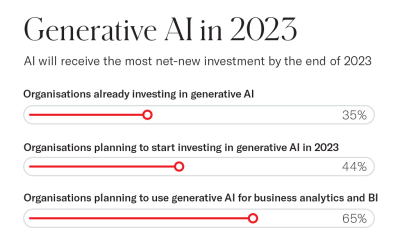In our last insight of 2022, we looked back on an amazing year of technology advancements. As we enter a new year, we look forward to the development of existing trends and the emergence of new ones. It is always difficult to make predictions in January, even more so in the fast-paced and complex times we live in.
One thing is certain: businesses are increasingly embracing digital transformation, encouraged by the rise in remote working and the need to retain talent while cutting costs. In 2022, 89% of businesses implemented a digital transformation strategy. The digital transformation market is set to reach $1,548.9 billion by 2027, and the global spending on technology to enable digital transformation is estimated to reach $2.3 trillion by 2030.

As a result, trends that did not have the expected success last year, such as the metaverse and blockchain technology, are very likely to boom in 2023.
While no prediction is set in stone, it is essential to take stock of the direction technology is taking, so organisations can stay at the forefront of innovation and build resilience. This insight explores seven digital transformation trends to watch in 2023.
1. Metaverse
The metaverse is arguably the most anticipated trend of 2023, but also one that is difficult to make predictions about. In 2022, we saw it fail for the most part, but we also saw virtual reality (VR) and augmented reality (AR) being used in the entertainment and creative industries. The 64th Grammy Awards were presented in Roblox, and a new category for Best Metaverse Performance was introduced at the MTV Video Music Awards (VMAs).
In 2023, the metaverse will see a further boost into the mainstream and is likely to become the preferred marketing channel of web 3.0. A range of competitors to Meta are set to emerge as both Apple and ByteDance (TikTok’s parent company) will release their own headsets.
Beyond marketing, the metaverse will provide new tools to do business and develop new products in the corporate world. For example, digital twins provide virtual simulations of products and are used to safely test prototypes and ideas in a digital environment.
Mixed reality technology will also see an uptake, particularly in sectors where it has already been used successfully such as construction, maintenance, and healthcare.
2. Increased investment in blockchain technology
Despite scepticism about cryptocurrency, investment in blockchain platforms outside the financial sector increased last year and will continue to do so in 2023.
The global blockchain market value is predicted to reach $67.4 billion by 2026 and, although the financial sector still accounts for 30% of the total market value, blockchain will grow at unprecedented rates in healthcare and public sector.

3. Adaptive and generative AI to react to changing business goals
Adaptive and generative artificial intelligence (AI) uses neural networks to create content and interpret information. We have seen these technologies become mainstream in 2022 in a trend that will grow further in the new year. Businesses in 2023 will use AI and machine learning to make data-driven decisions and quickly react to changing priorities and goals.
According to the Infotech Research Group, AI will receive the most net-new investment by organisations by the end of 2023, with 35% of organisations already investing in it and 44% planning to do so. Specifically, 65% of organisations plan to use generative AI for business analytics or intelligence.

4. Customer data platforms
Also useful for data-driven decisions, customer data platforms (CDP) bring together data from different sources and are especially used in marketing. CDPs allow companies to monitor each step of the customer journey and unify individual customers’ data to get a single view.
By getting insights from one secure database, businesses are able to quickly review and improve customer experience. In 2023, the goal should be to create effective data governance and make sure customers understand how their data is utilized.
5. Industry cloud and multicloud
AI is not the only way businesses are looking to increase efficiency in 2023. Organisations will continue to move to the cloud, so they can embrace collaboration. If 2022 was the year of software-as-a-service (SaaS) and platform-as-a-service (PaaS) solutions, this year will be dominated by everything as a service (XaaS).
XaaS solutions steer away from fragmented cloud offerings and make all services available as cloud-based subscription services. As remote working keeps growing, with nearly 60% of employees adopting hybrid working patterns, the cloud will become a fundamental tool in 2023.
6. Low-code platforms
There is an increasing demand for mobile and web applications that are easy to create and edit, partly due to a shortage of developers and programmers.
Developers spend much of their time writing long codes, with a higher chance of human error. Additionally, many small and medium businesses do not have the resources to hire professional developers and need accessible tools to create and test apps.
Low-code platforms allow professional developers to build apps and websites without coding line by line. At the same time, those who are not professional developers can build what they need without an extensive knowledge of programming languages.

7. Sustainable technology frameworks to achieve ESG goals
Finally, digital sustainability will likely be the main focus of 2023. With the climate crisis high on global governments agendas, businesses must build sustainable technology strategies to achieve environmental, social and governance goals (ESG).
With 90% of IT leaders recognising sustainability as a priority, businesses will have to harness data to measure their environmental impact and build on sustainable partnerships.

"Every business has a responsibility to evaluate how they can operate in a more sustainable way to limit their impact on the planet and have a positive influence on wider communities. At ROCK, we believe that corporate social responsibility is a core part of the digital transformation process - understanding and getting involved first-hand with the communities we work with is the first step to making a difference for our planet."
Kiera Barrett, Senior People Manager at ROCK.
Conclusion
The year ahead looks promising for digital transformation. From the metaverse to blockchain, new possibilities will emerge for businesses to increase their reach, revenue, and efficiency. Although some predictions might not come true, as we have seen for 2022, the digital transformation market will undoubtedly keep growing.
This growth is primarily driven by the need for data analytics tools and cloud computing. While further regulations are needed to protect privacy and data security, these technologies will dominate 2023 and, if used correctly, will be instrumental to achieving carbon neutrality.
References
- Adobe (2022) 6 digital transformation trends for 2023. Adobe Business 2 December 2022. [Accessed: 22 December 2022]
- Carter, R. (2022) The ultimate list of blockchain statistics 2023. Findstack 5 December 2022. [Accessed: 3 January 2023]
- Data Centre and Network News (2022) IT leaders recognise sustainability as a key objective in business. DCNN Magazine 7 February 2022. [Accessed: 3 January 2023]
- Markets and Markets (2022) Digital transformation market global forecast to 2027. [Accessed: 22 December 2022]
- Marr, B. (2022) The top 5 metaverse trends in 2023. Forbes 24 October 2022. [Accessed: 3 January 2023]
- PR Newswire (2022) New 2023 tech trends report from Infotech Research Group highlights 7 trends CIOs must anticipate for the coming year. PR Newswire 8 November 2022. [Accessed: 22 December 2022]